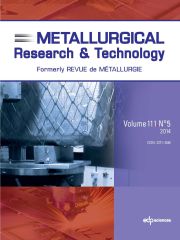Crossref Citations
This article has been cited by the following publications. This list is generated based on data provided by
Crossref.
Leimalm, Ulrika
Ökvist, Lena Sundqvist
and
Björkman, Bo
2008.
Effect of Different PCI Practice on the Texture Obtained during Reduction of Iron Oxide Pellets.
ISIJ International,
Vol. 48,
Issue. 12,
p.
1686.
Krztoń, H. J.
Niesler, M.
and
Kania, Z.
2013.
The application of the X-ray micro-diffraction to study some industrial problems.
Powder Diffraction,
Vol. 28,
Issue. S2,
p.
S133.
Murav’eva, I. V.
and
Bebeshko, G. I.
2017.
Determining the chlorine content in the blast-furnace system.
Steel in Translation,
Vol. 47,
Issue. 5,
p.
287.
Wang, Cui
Zhang, Jianliang
Liu, Zhengjian
Jiao, Kexin
Wang, Guangwei
Yang, Junqiang
and
Chou, Kuochih
2017.
Effect of Chlorine on the Viscosities and Structures of CaO-SiO2-CaCl2 Slags.
Metallurgical and Materials Transactions B,
Vol. 48,
Issue. 1,
p.
328.
Wang, Cui
Zhang, Jianliang
Jiao, Kexin
and
Liu, Zhengjian
2017.
Influence of basicity and MgO/Al2O3ratio on the viscosity of blast furnace slags containing chloride.
Metallurgical Research & Technology,
Vol. 114,
Issue. 2,
p.
205.
Li, Chuan Hui
Zhang, Jian Liang
Wang, Cui
Yan, Bing Ji
Zhang, Ya Peng
and
Guo, Hong Wei
2017.
Characterization of Minerals, Metals, and Materials 2017.
p.
737.
Wang, Cui
Zhang, Jian-liang
Wang, Guang-wei
Jiao, Ke-xin
Liu, Zheng-jian
and
Chou, Kuo-chih
2017.
Combustion characteristics and kinetics of anthracite with added chlorine.
International Journal of Minerals, Metallurgy, and Materials,
Vol. 24,
Issue. 7,
p.
745.
Wang, Xiaozhe
Yan, Zhiwu
Wang, Rongrong
Liu, Donghui
Zhang, Jianliang
and
Liu, Zhengjian
2018.
Study of the enrichment characteristics of sinter by alkali metal vapors.
Metallurgical Research & Technology,
Vol. 115,
Issue. 3,
p.
310.
Lan, Chenchen
Lyu, Qing
Liu, XiaoJie
Qie, Yana
and
Zhang, Shuhui
2019.
Effect of Cl on Softening and Melting Behaviors of BF Burden
.
High Temperature Materials and Processes,
Vol. 38,
Issue. 2019,
p.
273.
Königsberger, Erich
Spahiu, Kastriot
and
Herschend, Björn
2021.
Thermodynamic Study of the Chlorine Content of Stainless Steel.
Metallurgical and Materials Transactions B,
Vol. 52,
Issue. 2,
p.
840.
Hassan, Abdelrhman Ibrahim
Khalifa, Mohamed Gamal
Meraikib, Mohamed Aziz
and
Ahmed, Belal Saleh
2021.
Sintering of Bahariya Iron Ore Using Anthracite at the Egyptian Iron & Steel Company.
Metallurgist,
Vol. 65,
Issue. 1-2,
p.
3.
Mitrofanova, S. A.
and
Muravyeva, I. V.
2022.
Determination of Chlorine in Dusty Waste in Ferronickel Production: Analysis and Estimation of Uncertainty.
Steel in Translation,
Vol. 52,
Issue. 9,
p.
833.
Mitrofanova, S. A.
and
Murav’eva, I. V.
2022.
Determination of chlorine in dusty waste in ferronickel production: Analysis and estimation of uncertainty.
Izvestiya. Ferrous Metallurgy,
Vol. 65,
Issue. 9,
p.
629.
Kadhe, Dhiraj Madhukar
Sahoo, Manoj Kumar
Kumar, Mohit
Dwarapudi, Srinivas
Misra, Siddhartha
Choudhary, Pradeep
and
Sinha, Surajit
2025.
Alkali Mitigation in Iron Ore Sintering Through Coarse Coke-Induced CO Atmosphere.
Journal of Sustainable Metallurgy,


